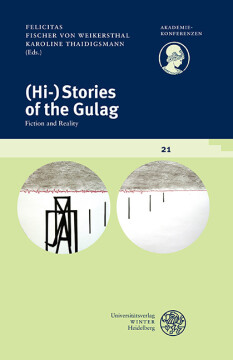
BUCH
(Hi-)Stories of the Gulag
Fiction and Reality
Herausgeber: Fischer von Weikersthal, Felicitas | Thaidigsmann, Karoline
Akademiekonferenzen, Bd. 21
2016
Zusätzliche Informationen
Bibliografische Daten
Abstract
After decades of being concealed and downplayed, the Soviet Gulag system is gradually gaining attention. The opening of archives following the fall of the Soviet Union, new editions of testimonial literature, and new media representations have fostered an increased interest in research into the Subject. Moreover, popular culture itself has embraced the Gulag. Thus, old and new representations in cultural media, as well as in academic research, all compete in narrating and interpreting the history of the Gulag. Which of these stories from and about the Gulag form our current understanding of the Soviet forced labor camps? And where can we situate them within the dichotomous field of facticity and fictitiousness? By bringing together international researchers from historical sciences, literary and cultural studies, film studies, and musicology to analyze the validity and significance of existing Gulag narratives and discuss their impact on the public’s perception, the volume contributes to a more thorough understanding of this complex Subject.
Inhaltsverzeichnis
| Zwischenüberschrift | Seite | Aktion | Preis |
|---|---|---|---|
| Cover | C | ||
| Title Page | iii | ||
| Copyright | iv | ||
| Contents | v | ||
| Introduction. Felicitas Fischer von Weikersthal, Karoline Thaidigsmann | 9 | ||
| Galina IVANOVA, Competing Realities: Statistics, Memoirs and the History of the Gulag [Die Gulag-Statistiken im Spiegel von Archivmaterialien und Memoiren] | 21 | ||
| Dan HEALEY, “Dramatological” Trauma in the Gulag. Malingering, Self-Inflicted Injuries and the Prisoner-Patient | 37 | ||
| Friedrich GEIGER, Music in the Recollections of Political Gulag Prisoners | 63 | ||
| Felicitas Fischer VON WEIKERSTHAL, Appearance and Reality. Nazi Germany and Gulag-Memoirs | 75 | ||
| Manuela PUTZ, „Auf dem Weg nach vorne. Polithäftlinge sind wir“. Politische Gefangenschaft, transnationale Netzwerke und Identitätskonstruktionen Andersdenkender in der Sowjetunion der 1960er bis 1980er Jahre | 101 | ||
| Zuzanna BOGUMIŁ, The Solovetski Islands and Butovo as two “Russian Golgothas”. New Martyrdom as a Means to Understand Soviet Repression | 133 | ||
| Anne HARTMANN, Fiction and Reality: Literary Testimonies Between Document and Fictionalization Erschöpft und usurpiert. Plädoyer für ein erweitertes Konzept von Gulag-Literatur | 159 | ||
| Andrea GULLOTTA, Gulag Poetry. An Almost Unexplored Field of Research | 175 | ||
| Leona TOKER, Rereading Varlam Shalamov’s Stories June and May. Four Kinds of Knowledge | 193 | ||
| Alfred GALL, Disconcerting Concision. Laconism as Principle of Text Organization – Leo Lipski (Dzień i noc) and Lev Konson (Kratkie povesti) | 205 | ||
| Łukasz Neca, Fiktive Wirklichkeiten – wirkliche Fiktionen. Gustaw Herling-Grudzinskis Inny swiat und Wlodzimierz Odojewskis Zabezpieczanie sladów | 219 | ||
| Renate LACHMANN, Document or Fiction? Karlo Štajner and Danilo Kiš | 237 | ||
| Karoline THAIDIGSMANN, Inventing the Gulag: Approaches in Contemporary Literature, Music and Film Visitors to the Gulag. Soviet Forced Labor in Contemporary Western Fiction for Adult and Young Readers | 255 | ||
| Nina A. FRIEß, “From Russia with Blood”. Stalinist Repression and the Gulag in Contemporary Crime Fiction | 281 | ||
| Oksana BULGAKOWA, Die filmische Darstellung von Körperlichkeit in extremen Situationen | 303 | ||
| Irina GRADINARI, Der Soldat als Befreier? Zur Stalinismus-Kritik in der Serie Poslednij boj majora Pugaceva | 323 | ||
| Inna KLAUSE, Russkij šanson. Geschichte(n) aus dem Gulag oder populäre Verklärung der Historie? | 353 | ||
| Notes on Contributors | 371 | ||
| Index | 375 |


 Publishing Platform by CloudPublish
Publishing Platform by CloudPublish